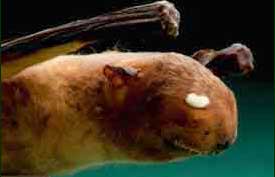Philippine Bare-Backed Fruit Bat
Dobsonia chapmani
In the lowlands of Negros Island once lived another fruit bat, a bit larger than the tube-nosed bat and belonging to a group called bare-backed bats(Dobbsonia chapmani)—so named because the leathery part of their wings attach to the body up near their spine, giving the appearance that there is no fur on their backs (though it actually is present beneath the skin of the wings). These bats roosted in caves near the coast, in rooms near the mouth of the cave where some dim light penetrated. The roosting colonies would swell when adult females came together to give birth to their single young during April and May, near the end of the dry season. Each evening, the bats would fly out to feedon fruit in both old-growth and disturbed forest.
At the end of World War II, 60 percent of Negros was covered by rain forest. As subsidies for sugar increased, virtually all of the flat lowlands were cleared for plantations. Subsistence farmers who had occupied some of this land were forced higher into the hills, clearing the upper reaches of lowland forest. When work in the cane fields was not available, plantation workers, paid barely enough to survive, would mine guano (bat excrement) from caves and sell it as fertalizer for a few pesos. They lit the caves with small fires whose smoke accumulated in asphyxiating clouds in the cave ceilings. Bats of many species that fellfrom the ceilings were roasted over the fires, a welcome source of protein to the impoverished workers.
By the mid-1980s, the last of the forest on Negros below 800 meters elevation had been cleared, and the remnants of upland forest covered only six percent of the island. With the ascendency of sugar-cane plantations, the rural poor remained as impoverished as ever, but the guano, and the bats that produced it, were nearly gone. The largest of the bats, those that lived near the entrances and that offered the most meat, were entirely gone—the first mammalian species in the Philippines to be documented as extinct in modern times.
Original URL: http://archive.fieldmuseum.org/vanishing_treasures/V_BBFruitBat.htm

